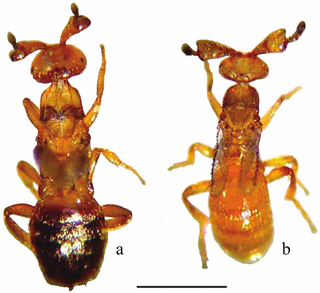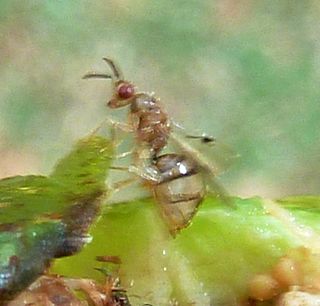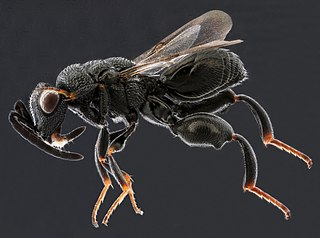
Chalcid wasps are insects within the superfamily Chalcidoidea, part of the order Hymenoptera. The superfamily contains some 22,500 known species, and an estimated total diversity of more than 500,000 species, meaning the vast majority have yet to be discovered and described. The name "chalcid" is often confused with the name "chalcidid", though the latter refers strictly to one constituent family, the Chalcididae, rather than the superfamily as a whole; accordingly, most recent publications (e.g.,) use the name "chalcidoid" when referring to members of the superfamily.

Melittobia is a genus of hymenopteran insects of the family Eulophidae.
Epistenia is a genus of wasps in the family Pteromalidae.
Metapelma is a parasitic wasp genus in the family Eupelmidae.

Sycophila is a genus of wasp that associates with figs. They have a cosmopolitan distribution.
Heydenia is a genus of wasps in the family Pteromalidae.

Megastigmus is a genus of minute wasps. There are more than 134 described species, more than half of which undergo larval development within the seeds of trees and shrubs.
Cleonymus is a genus of wasps in the family Pteromalidae.
Entedoninae is a subfamily of chalcid wasps from the family Eulophidae which includes over 90 genera.
Eulophinae is a subfamily of chalcid wasps from the family Eulophidae which includes over 90 genera.

Leucospis is a genus of wasps belonging to the family Leucospidae. Most species are brightly coloured with yellow and black patterning and about 2 cm long. They have characteristically enlarged femurs on the hind leg with the lower margin toothed. The wings have a longitudinal fold and the long ovipositor is bent over their backs above the abdomen or metasoma. They are parasitic on wasps and solitary bees that construct cells and provision food for their offspring. The Leucospis larvae live and grow as ectoparasites of the host larvae. Usually, only, one parasite emerges from a single cell. The genus Micrapion from South Africa is very closely related and phylogenetic studies suggest merging of the two genera. The genus Leucospis is found across the world in the tropical regions.

Euperilampus is a genus of chalcid wasps in the family Perilampidae. There are about 18 described species in Euperilampus.

Haltichella is a genus of chalcidid wasps in the family Chalcididae. There are at least 20 described species in Haltichella.

Orasema is a genus of chalcid wasps in the family Eucharitidae. There are at least 50 described species in Orasema.

Psilochalcis is a genus of chalcidid wasps in the family Chalcididae. There are at least 20 described species in Psilochalcis.

Conura is a genus of chalcidid wasps in the family Chalcididae, containing more than 300 species described. They are distributed mostly in the New World, especially in the Neotropical region, where 279 species occur. Conura is divided into three subgenera and 63 species groups, which may not form taxonomic entities but reflect patterns of morphology that are useful for focused studies.

Eucharitinae is a subfamily of chalcid wasps in the family Eucharitidae.












